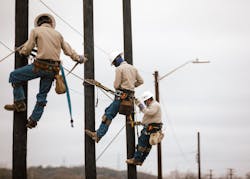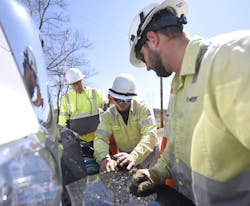Shirley Bloomfield, CEO of NTCA–The Rural Broadband Association, Looks at Progress Made in 2023
2023 has been a monumental year for broadband. From the ReConnect program overseen by the U.S. Department of Agriculture (USDA), to the American Rescue Plan Act (ARPA) funds being distributed by the U.S. Treasury through the states—and from the Federal Communications Commission’s (FCC) universal service fund programs, to new programs launched by the National Telecommunications and Information Administration (NTIA)—there has never been a year like 2023 when it comes to finding ways to reach the millions of Americans still longing for better broadband access.
Of course, the biggest deployment program is still to come, with NTIA and the states ramping up to distribute tens of billions of dollars through the Broadband Equity, Access, and Deployment (BEAD) program with the goal of ensuring that every unserved American has broadband access by 2030.
“…if we learned anything from prior broadband programs, it should be that the customer comes first—and program rules should be designed in a way that gives those customers robust and reliable broadband rather than access to a network that in just a few years’ time falls far short again.”
But before we get to the promise of BEAD—and the work still needed to make that work—let’s look back at the programs that are already working because we can see the substantial progress made and draw some lessons for what comes next.
In 2023, for example, the USDA has given out more than $1.5 billion in funding through ReConnect, with more than $800 million flowing to small, community-based broadband providers in NTCA’s membership to deploy future-proof broadband networks in deeply rural areas. This program—along with the ARPA-funded state grant programs—has been highly successful in years past in prompting construction of cutting-edge networks that will meet the needs of consumers today and tomorrow, and we have high hopes for the funds awarded in 2023 as well.
Meanwhile, NTIA and each state have been working at a fast and furious pace over the course of this year to implement the $42.5 billion BEAD program. At the end of June, President Biden announced the amount each state will receive from the BEAD program, and I am grateful to have been in the room for the historic announcement. The buzz in the security line getting into the event itself was electric as folks lined up early in uncharacteristic Washington, D.C. style.
Throughout the late summer and into the fall, state broadband offices have been working diligently to develop their Initial BEAD Proposals, which are due by the end of the year. To help these offices and stakeholders of all kinds as they race toward this finish line, NTCA worked with the Fiber Broadband Association to release the third iteration of our Broadband Infrastructure Playbook this fall.1 Over the course of these releases, this tool has aimed to provide easy-to-follow guidance and recommendations on successful implementation of a BEAD-funded grant program. As the state broadband offices complete this work over the next few months, NTIA will then have to review and approve these plans, meaning that BEAD funding may not flow until the first half of 2024 in even the most early acting states and not until later next year or into 2025 in others.
As we get closer to the launch of the historic BEAD program, this is a good opportunity to highlight the lessons we learned from how broadband grant programs have worked in 2023 and years past.
For example, even something as simple as the timing of program implementation can be critical, in that if a grant is awarded in the late fall or during the winter, in many states this means construction won’t start for months while the ground is frozen. Add to that the time it takes to apply for and receive permits from federal, state, local, and tribal governments and entities, and it could be a significant challenge to complete construction within the ambitious four-year deadlines of the BEAD program. So, timing—and streamlining processes where possible to help with timing—needs to be a critical piece of any state plan for BEAD.
Another important lesson to draw from earlier initiatives like ReConnect and some of the FCC’s universal service fund (USF) programs is “getting it right the first time.” Too often, we’ve aimed just “to get something to everyone,” with the result being deployment of broadband networks that quickly appear outdated and require reinvestment soon thereafter.
Even now there’s a debate in Congress over whether to change the ReConnect standards to expect improved performance or to ratchet them downward so that certain kinds of providers have a better chance of winning. In the end, if we learned anything from prior broadband programs, it should be that the customer comes first—and program rules should be designed in a way that gives those customers robust and reliable broadband rather than access to a network that in just a few years’ time falls far short again.
Yet another lesson to draw from 2023 and recent years is that the work of connecting communities is not finished simply because a network has been built. To the contrary, the work is just beginning once the network is completed. If one puts the customer first again, it’s clear that customers don’t just need networks—they need services. And this is where the FCC’s universal service initiatives are critical, recognizing the difficulty of sustaining rural networks and keeping rates for services affordable in sparsely populated areas.
Even as the new grant programs offer great promise, they are just a step toward universal service rather than final achievement of that goal. The FCC has taken significant steps in recent years to refocus its essential USF programs on this mission of sustainability of networks and services, and while creating many of these new grant programs, Congress also explicitly directed the FCC to neither abandon nor neglect the more comprehensive mission of universal service. Even as aspects of these long-running USF programs face challenges now in courts—more than 25 years after their creation—we hope that the interest of Congress in supporting this universal service mission will remain strong and resolute.
And of course, you can’t have a network if you don’t have the workforce to build it. Like other sectors, the broadband industry faces a shortage of skilled workers. That is why NTCA partnered with Northwood Technical College in Rice Lake, Wisconsin, to provide NTCA members with online access to Northwood’s Broadband Academy courses and “Digital Badging” program,2 which provides employees with professional development opportunities and provides companies with a pipeline of skilled workers. Even if you are not an NTCA member, continued learning opportunities and certifications can help ensure your knowledge and skills are up to date in an industry that is constantly changing and evolving.
In addition to ensuring the current workforce has the technical skills and certifications necessary, we believe it is never too early to engage with the next generation. NTCA members have been particularly focused on this area, with members hosting internship programs and job fairs, working with their schools to develop a STEM curriculum, and even supporting esports and robotics teams and hosting tournaments to engage with students who may be interested in engineering or other technical jobs down the line.
While many of these students are too young to play a significant role over the next few years, a focus on “growing our own” can bring them into the fold down the line. To that end, the Foundation for Rural Service, the philanthropic arm of NTCA, published a “Guide to Careers in Rural Telecommunications”3 to highlight the types of job opportunities available within local rural telecommunications companies.
And NTCA’s Smart Communities program teamed up with the National Rural Education Association to create the Broadband Opportunities and Leadership Development (BOLD) K-12 Career Awareness Toolkit,4 which provides guidance and best practices for locally operated communications providers and educators to create more awareness of broadband careers among K-12 students. Both educational resources are available for free online.
A final item worth highlighting is how cybersecurity has become an increasing focus over the past year, with BEAD and other broadband funding programs now requiring recipients to have cybersecurity and supply chain risk management plans in place. To help NTCA members in becoming more aware of these issues and obtaining greater information on mitigating such risks, we operate CyberShare: The Small Broadband Provider ISAC and offer a sector-specific guide to help companies enhance their cyber posture and resiliency.
It's clear there is no shortage of issues as we continue the work of closing the digital divide. But, at the same time, the future of broadband is as bright as it ever has been, and NTCA stands ready to help small broadband providers navigate these issues and deliver the best possible broadband for the benefit of rural America.







